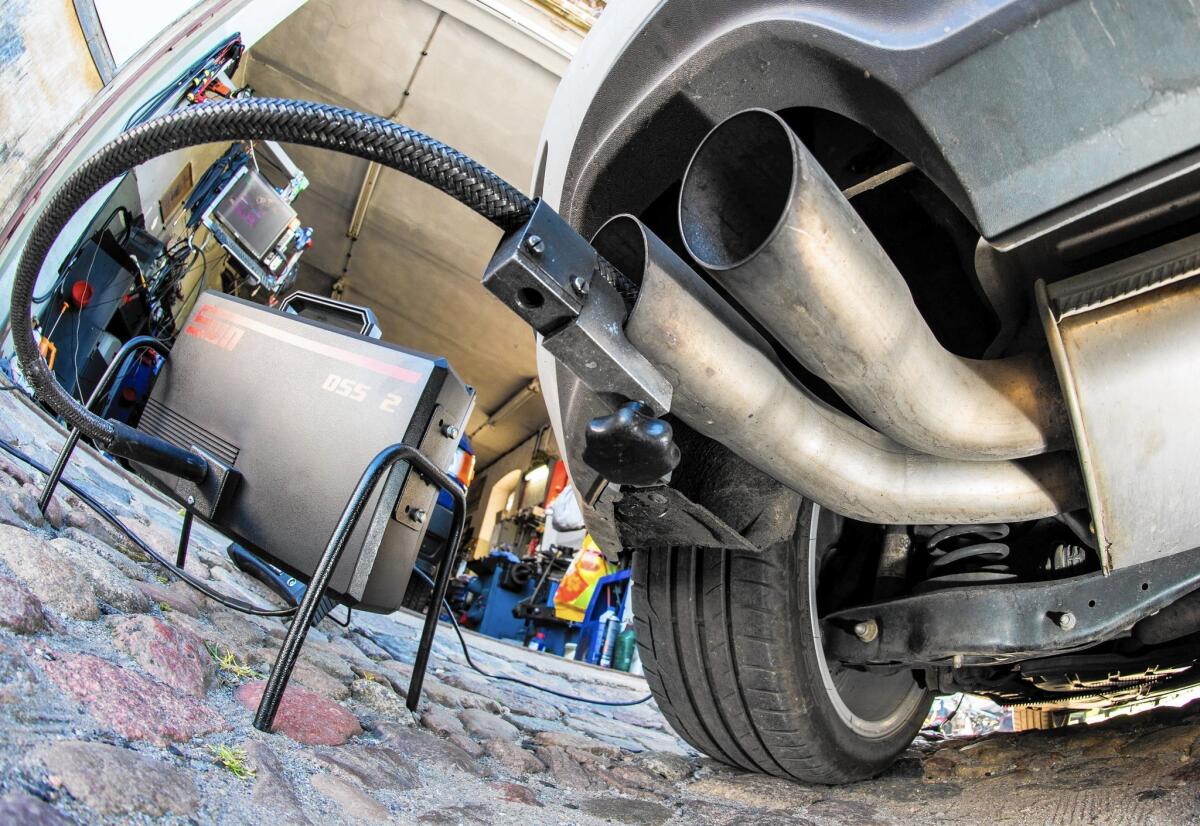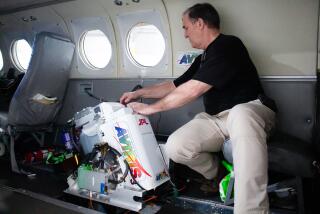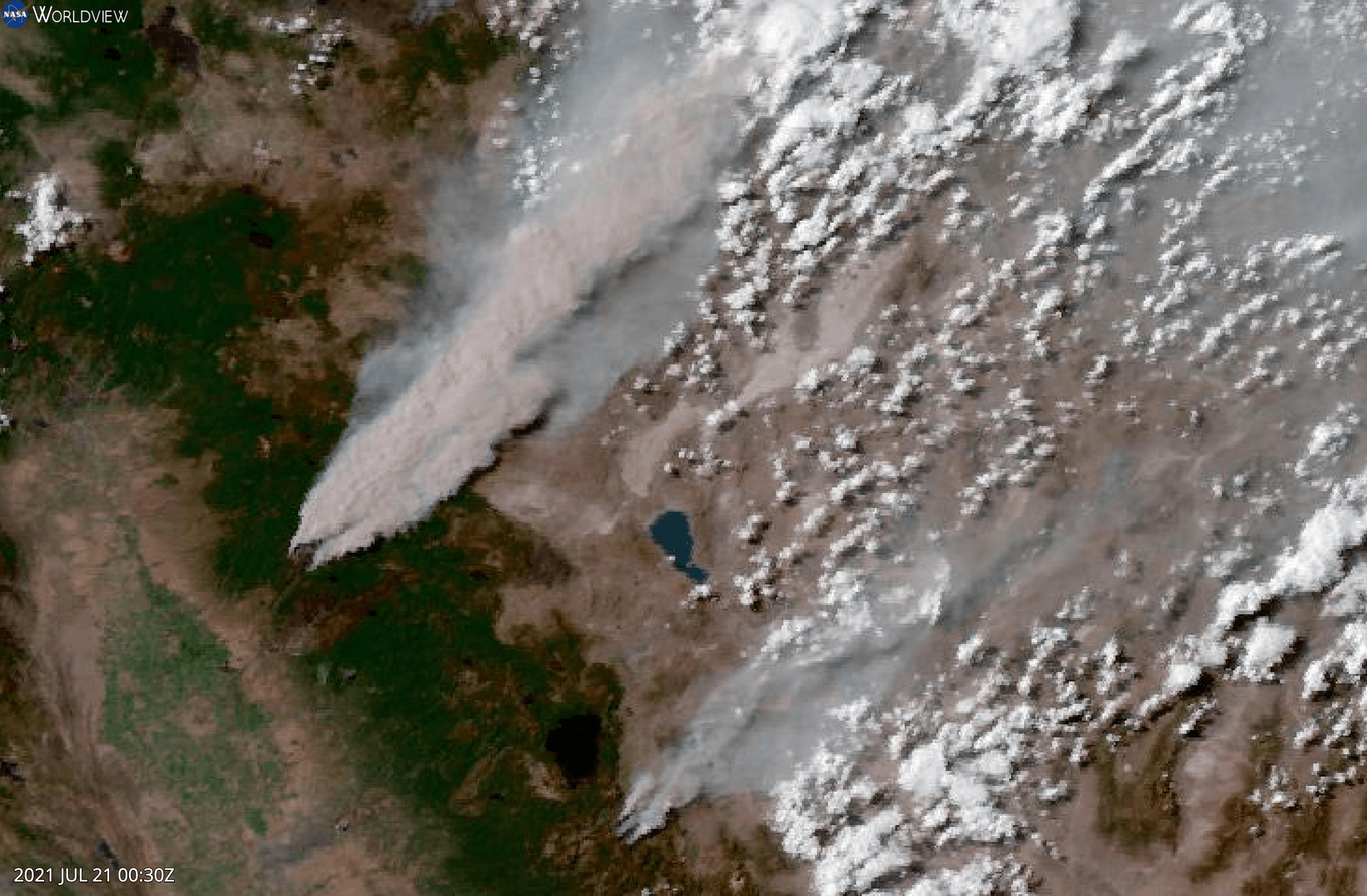New technology is keeping the air we breathe under an unprecedented level of scrutiny

- Share via
Measure twice, cut once, they say. Unless you are trying to save the planet.
In that case, measure and cut constantly.
Rising calls to create cleaner air and limit climate change are driving a surge in new technology for measuring air emissions and other pollutants — a data revolution that is opening new windows into the micro-mechanics of environmental damage.
The momentum for new monitoring tools is rooted in increasingly stringent regulations, including California’s cap-and-trade program for greenhouse gas emissions, and newly tightened federal standards and programs to monitor drought and soil contamination.
A variety of clean-tech companies have arisen to help industries meet the new requirements, but the new tools and data are also being created by academics, tinkerers and concerned citizens — just ask Volkswagen, whose deceptive efforts to skirt emissions-testing standards were discovered with the help of a small university lab in West Virginia.
Taking it all into account, the Earth is coming under an unprecedented new level of scrutiny.
For more than a year, satellites launched by NASA’s Jet Propulsion Laboratory have been orbiting Earth to track the global flow of carbon emissions. In Colorado, workers are using infrared cameras to find methane leaking from natural gas wells. In Boston, researchers using new measuring devices have detected “fugitive emissions” in hundreds of places across the city, including the Massachusetts State House.
Los Gatos Research in Silicon Valley now makes portable equipment for measuring greenhouse gases and other pollution that has been used on airplanes and in national forests. Piccaro, another California company, makes the machines that have been used to measure methane leaks in Boston and other cities. Other startups have created software that collects existing air quality data into apps that can advise asthmatics on areas to avoid and steer cyclists toward the least-polluted paths to work.
We’re in this moment of a huge growth in curiosity -- of people trying to understand their environment. That coincides with the technology to do something more.
— Colette Heald, atmospheric chemist at the Massachusetts Institute of Technology
“There are a lot of companies picking up on this, but who is interested in the data — to me, that’s also fascinating,” said Colette Heald, an atmospheric chemist at the Massachusetts Institute of Technology. “We’re in this moment of a huge growth in curiosity — of people trying to understand their environment. That coincides with the technology to do something more.”
The push is not limited to measuring air and emissions. Tools to sample soil, test seismic regions, monitor water quality, test ocean acidity and improve weather forecasting are all on the rise. Drought has prompted new efforts to map groundwater and stream flows across the West. In space, NASA recently began a global precipitation measurement program intended, in part, to more accurately predict extreme weather events and the availability of water.
The Obama administration has rolled out a series of regulatory changes intended either to reduce pollutants in the air people breathe or limit greenhouse gases — and sometimes both. This month, the Environmental Protection Agency finalized new rules to reduce ozone and, for the first time, required so-called fenceline testing near oil refineries to track pollutants such as benzene that may be escaping — a task that requires sensitive monitoring equipment.
Industry groups often oppose new rules because complying costs money, but these rules can also drive technological development and new industries. While older emissions-monitoring devices may occupy the footprint of a living room, equipment is being developed that is portable and more sophisticated.
“Fifteen years ago we were talking about percent — the percentage of a particular species in a gas,” said Chris Anthony, who oversees analytical products for the ABB Group, which has expanded its investments in air and gas monitoring in recent years, including buying Los Gatos Research in 2013. “Five years ago, 10 years ago, we started talking about parts per million. In many areas now, we’re measuring parts per billion, which is very, very low levels of trace gas in exhaust.”
Chet Wayland, the director of the air quality assessment division within the EPA’s office of air quality planning and standards, recalled a research conference the agency hosted a few years ago where he met a graduate student who showed him a hand-held, homemade device that measured air pollution. The parts appeared to cost about $50.
“It wasn’t great but it was not bad,” Wayland recalled. “I’m sitting there going, ‘Oh, my gosh.’ I’m used to working in the world where these devices are $30,000 and they’re highly sophisticated, and here’s somebody who built this in a lab basically by himself. That’s when I realized that the world was changing.”
Wayland and one of his colleagues, Dan Costa, who works on air and climate issues in the EPA’s Office of Research and Development, said that as more companies and individuals make affordable equipment, they need to demonstrate that their products are accurate and reliable.
“That’s one of the key issues we at the EPA are trying to focus on,” Wayland said. “When the technology is out there and everyone starts using it, the question is, how good is the data? If the data’s not high enough quality, then we’re not going to make regulatory decisions based on that.”
He added, “Where is this data going to reside in 10 years, when all these sensors are out there, and who’s going to [manage] that information? Right now it’s kind of organic so there’s no centralized place where all of this information is going.”
Two years ago, Heald, the professor at MIT, helped lead a group of students who created a campus air quality monitoring network. They launched a website where people can track gases such as ozone and carbon monoxide.
But the site also includes a disclaimer, warning that the numbers were not necessarily “regulatory grade” measurements. Costa said the EPA’s long-term vision is “this harmonization, a synthesis of the gold standard monitoring network [run by government] with the evolving sensor technology” used by citizen groups and individuals.
Satellites are expected to play an increasing role in that goal. New equipment is being developed by NASA that will provide multiple daily readings of air pollutants from a geostationary satellite, and the agency’s Orbiting Carbon Observatory, launched last year and run from the Jet Propulsion Laboratory at the California Institute of Technology, is intended to help scientists study how carbon travels.
“To understand our impact on the atmosphere and temperature changes in the future, you’ve got to know how that stuff’s going to move around — and we don’t know that very well right now,” said Annmarie Eldering, a NASA scientist who helps run the project.
Her colleague Riley Duren, who helps oversee the study of carbon emissions from large cities, noted that a satellite had helped spot methane hot spots over New Mexico’s San Juan Basin and in the Central Valley, which were then tracked down more precisely with the help of aircraft and infrared cameras.
“We throw everything but the kitchen sink at this,” Duren said.
ALSO
Why some homeowners are no longer cool with backyard pools
Insurance start-up Oscar seeks to shake up healthcare through its app
Oregon shooting victim recounts ordeal, takes on conspiracy theorists
More to Read
Sign up for Essential California
The most important California stories and recommendations in your inbox every morning.
You may occasionally receive promotional content from the Los Angeles Times.











